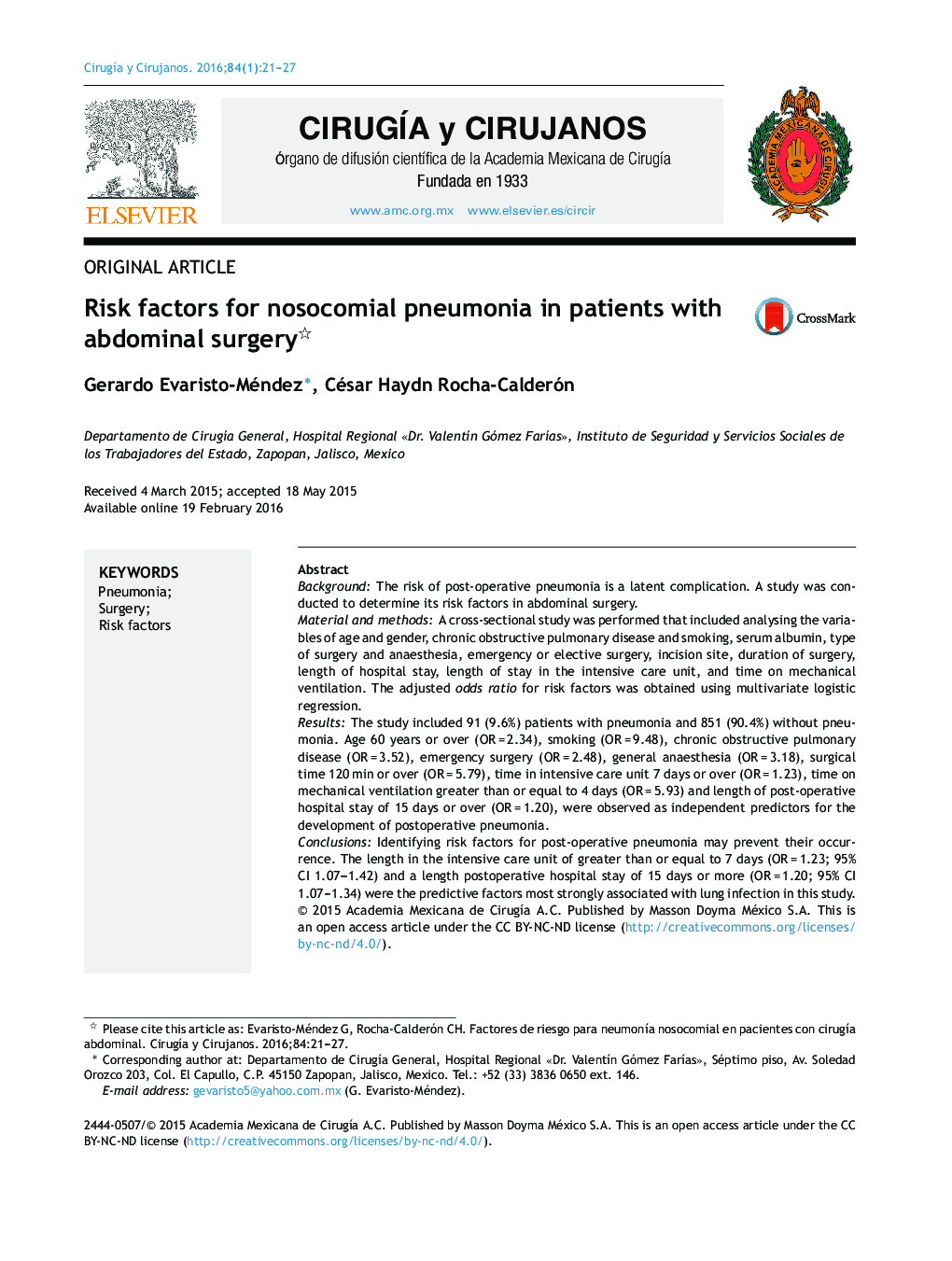| کد مقاله | کد نشریه | سال انتشار | مقاله انگلیسی | نسخه تمام متن |
|---|---|---|---|---|
| 4283385 | 1286884 | 2016 | 7 صفحه PDF | دانلود رایگان |
BackgroundThe risk of post-operative pneumonia is a latent complication. A study was conducted to determine its risk factors in abdominal surgery.Material and methodsA cross-sectional study was performed that included analysing the variables of age and gender, chronic obstructive pulmonary disease and smoking, serum albumin, type of surgery and anaesthesia, emergency or elective surgery, incision site, duration of surgery, length of hospital stay, length of stay in the intensive care unit, and time on mechanical ventilation. The adjusted odds ratio for risk factors was obtained using multivariate logistic regression.ResultsThe study included 91 (9.6%) patients with pneumonia and 851 (90.4%) without pneumonia. Age 60 years or over (OR = 2.34), smoking (OR = 9.48), chronic obstructive pulmonary disease (OR = 3.52), emergency surgery (OR = 2.48), general anaesthesia (OR = 3.18), surgical time 120 min or over (OR = 5.79), time in intensive care unit 7 days or over (OR = 1.23), time on mechanical ventilation greater than or equal to 4 days (OR = 5.93) and length of post-operative hospital stay of 15 days or over (OR = 1.20), were observed as independent predictors for the development of postoperative pneumonia.ConclusionsIdentifying risk factors for post-operative pneumonia may prevent their occurrence. The length in the intensive care unit of greater than or equal to 7 days (OR = 1.23; 95% CI 1.07–1.42) and a length postoperative hospital stay of 15 days or more (OR = 1.20; 95% CI 1.07–1.34) were the predictive factors most strongly associated with lung infection in this study.
ResumenAntecedentesEl riesgo de neumonía postoperatoria es una complicación latente. Realizamos una investigación para definir sus factores de riesgo en cirugía abdominal.Material y métodosMediante un estudio transversal analizamos la edad y género, enfermedad pulmonar obstructiva crónica y tabaquismo, albúmina sérica, tipo de cirugía y de anestesia, operación de urgencia o electiva, sitio de la incisión, duración de la operación; tiempo de hospitalización, en la Unidad de Cuidados Intensivos y, en Ventilación Mecánica Asistida. Por regresión logística multivariado obtuvimos la odds ratio ajustada para los factores de riesgo.ResultadosEstudiamos a 91 (9.6%) pacientes con neumonía y, 851 (90.4%) sin neumonía. Identificamos la edad ≥ 60 años (OR = 2.34), el tabaquismo (OR = 9.48), la enfermedad pulmonar obstructiva crónica (OR = 3.52), la intervención quirúrgica de urgencia (OR = 2.48), la anestesia general (OR = 3.18), el tiempo quirúrgico ≥ 120 min (OR = 5.79), el tiempo en la Unidad de Cuidados Intensivos ≥ 7 días (OR = 1.23), el tiempo en ventilación mecánica asistida ≥ 4 días (OR = 5.93) y el tiempo de hospitalización postoperatoria ≥ 15 días (OR = 1.20) como factores predictivos independientes para el desarrollo de neumonía postoperatoria.ConclusionesLa identificación de factores de riesgo para la neumonía postoperatoria puede prevenir su aparición. El tiempo en la Unidad de Cuidados Intensivos ≥ 7 días (OR = 1.23; IC del 95%, 1.07–1.42) y de hospitalización postoperatoria ≥ 15 días (OR = 1.20; IC del 95%, 1.07–1.34) fueron los factores predictivos más fuertemente asociados con la infección pulmonar en nuestro estudio.
Journal: Cirugía y Cirujanos (English Edition) - Volume 84, Issue 1, January–February 2016, Pages 21–27
